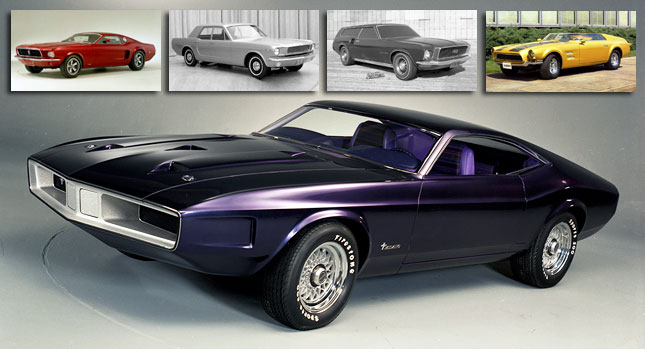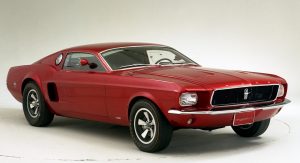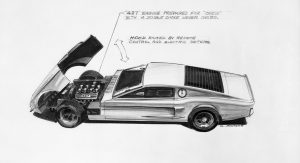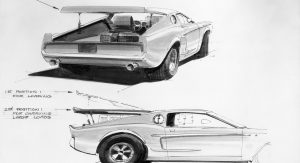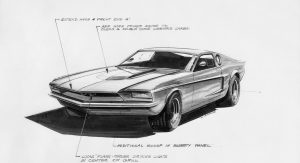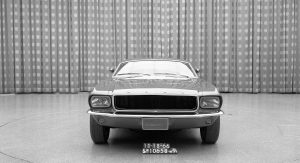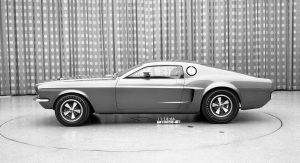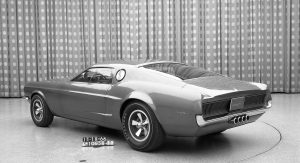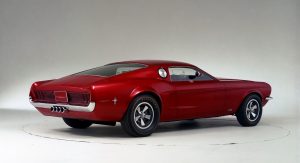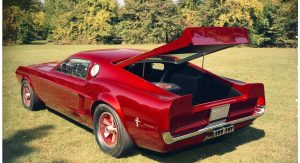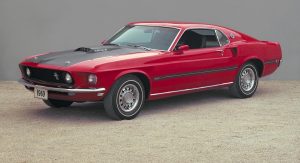As part of the celebrations leading up to the 50th anniversary of the Mustang on April 17, 2014, and the launch of the all-new 2015 Mustang, Ford has released photos of some of the pony car studies that never made it to production.
Over the past five decades, Ford designers and engineers have come up with many proposals for Mustangs that, for one reason or another, never had the chance to be produced. However, some of the prototypes survive and now Ford is showcasing them to make us wonder what might have been had they made it to series production. So, without further ado, let’s start the presentations.
By Dan Mihalascu

1961 Avventura, Avanti, Allegro
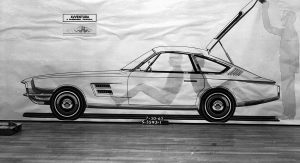 From late 1961 to mid-1962, Ford designers experimented with a wide range of themes for a sporty coupe based on the platform of the new Falcon compact. Each design was given an internal name, but one fastback design actually had at least three names, starting with Avventura before moving on to Avanti and finally Allegro. As the sketch shows, the fastback design was originally intended to be a hatchback with rear-facing second row seat. Although it was never produced, a variation of the fastback profile was eventually adopted as the third body-style for Mustang.
From late 1961 to mid-1962, Ford designers experimented with a wide range of themes for a sporty coupe based on the platform of the new Falcon compact. Each design was given an internal name, but one fastback design actually had at least three names, starting with Avventura before moving on to Avanti and finally Allegro. As the sketch shows, the fastback design was originally intended to be a hatchback with rear-facing second row seat. Although it was never produced, a variation of the fastback profile was eventually adopted as the third body-style for Mustang.

Avanti/Allegro Concept
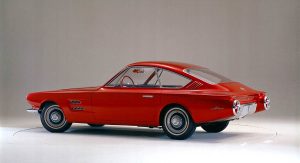 The transition from sketch to physical design model saw the Avventura losing the hatch, which was replaced with a trunk, while the rear seat was now forward-facing. The study was originally known as Avanti, but the name was changed to Allegro because Studebaker had introduced the Avanti coupe around the same time.
The transition from sketch to physical design model saw the Avventura losing the hatch, which was replaced with a trunk, while the rear seat was now forward-facing. The study was originally known as Avanti, but the name was changed to Allegro because Studebaker had introduced the Avanti coupe around the same time.

1961-1962 Two-Seater Studies
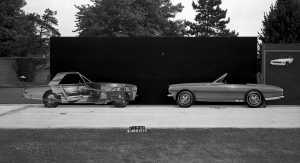 Ford designers considered a number of two-seater studies, which were seen as a more affordable return to the roots of Thunderbird, which by this time had become a four-seater. Interestingly, there has never been a strictly two-seat production Mustang, with the exception of some track-oriented models that had the rear seats removed to save weight.
Ford designers considered a number of two-seater studies, which were seen as a more affordable return to the roots of Thunderbird, which by this time had become a four-seater. Interestingly, there has never been a strictly two-seat production Mustang, with the exception of some track-oriented models that had the rear seats removed to save weight.

1962 Allegro Design Study
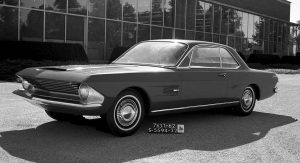 Another Allegro design surfaced in 1962 as the work of a design team led by Gene Bordinat. This particular study is responsible for the basic proportions that would define most Mustangs for the next five decades: the long hood, short deck and compact greenhouse became a hallmark of production Mustangs ever since.
Another Allegro design surfaced in 1962 as the work of a design team led by Gene Bordinat. This particular study is responsible for the basic proportions that would define most Mustangs for the next five decades: the long hood, short deck and compact greenhouse became a hallmark of production Mustangs ever since.

1963 Two-Seat, Mid-Engine Mustang Concept
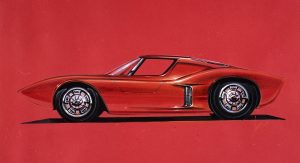 This hard-top variation of the Mustang 1 concept from 1962 was probably never seriously considered for production as a Mustang, but it did provide some inspiration for the GT40 Mk1 that began racing at Le Mans in 1964.
This hard-top variation of the Mustang 1 concept from 1962 was probably never seriously considered for production as a Mustang, but it did provide some inspiration for the GT40 Mk1 that began racing at Le Mans in 1964.

1964 Two Seater Study
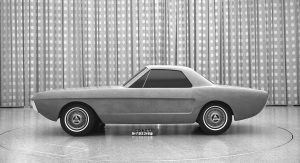 This is a clay model from 1964 representing a two-seat Mustang. The model incorporates some of the design cues of the first generation Mustang, more specifically the 1965 model year, including the side scoops.
This is a clay model from 1964 representing a two-seat Mustang. The model incorporates some of the design cues of the first generation Mustang, more specifically the 1965 model year, including the side scoops.

1965 Four-Door Mustang
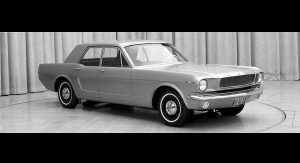 The success of the first-generation Mustang made Ford execs think about new body-styles to gain even more customers. As the Mustang was based on the Falcon sedan, the idea to add two doors to the pony car was inevitable. Fortunately, the design didn’t get approved and the Mustang legend was not diluted.
The success of the first-generation Mustang made Ford execs think about new body-styles to gain even more customers. As the Mustang was based on the Falcon sedan, the idea to add two doors to the pony car was inevitable. Fortunately, the design didn’t get approved and the Mustang legend was not diluted.

1966 Mustang Station Wagon
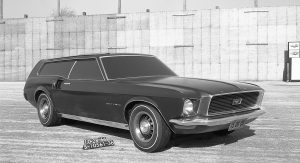 Another bodystyle that was seriously considered in the mid-1960s was a station wagon. At least one running prototype based on a 1966 coupe was built, while another design study included elements for refreshed models that were coming later that decade. All of the known Mustang wagons were three-doors that were closer to a European “shooting brake” than a traditional American family station wagon.
Another bodystyle that was seriously considered in the mid-1960s was a station wagon. At least one running prototype based on a 1966 coupe was built, while another design study included elements for refreshed models that were coming later that decade. All of the known Mustang wagons were three-doors that were closer to a European “shooting brake” than a traditional American family station wagon.

1967 Allegro II Concept
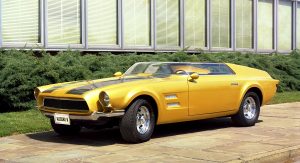 In 1967, Ford designers took one of the concepts from 1962 and transformed it by removing the greenhouse and replacing it with a low-cut speedster-style windshield, rollbar, flying buttresses on the rear deck and a new rear end.
In 1967, Ford designers took one of the concepts from 1962 and transformed it by removing the greenhouse and replacing it with a low-cut speedster-style windshield, rollbar, flying buttresses on the rear deck and a new rear end.

1966 Mach 1 Concept
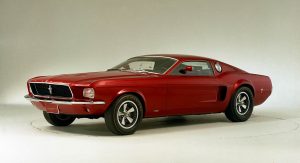
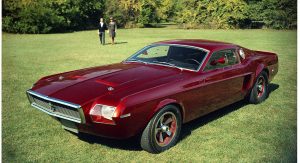 Created as a preview of the 1968 model, the Mach 1 Concept originally had a nose that drew inspiration from the 1963 Mustang II concept. Later on, the Mach 1 grew a new face that was closer to production Mustangs of the time. Although the low-cut roofline and racing-type fuel cap never made it to production, the hatchback did arrive on the 1974 Mustang II.
Created as a preview of the 1968 model, the Mach 1 Concept originally had a nose that drew inspiration from the 1963 Mustang II concept. Later on, the Mach 1 grew a new face that was closer to production Mustangs of the time. Although the low-cut roofline and racing-type fuel cap never made it to production, the hatchback did arrive on the 1974 Mustang II.

1967 Mach 2 Concept
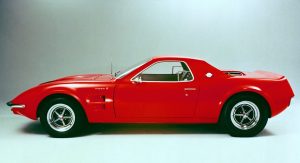 The Mach 2 concept featured a 289 cubic-inch (4.73-liter) Hi-Po V8 that was shifted from the front to behind the two seats to evaluate the layout as a possible successor to the Shelby Cobra. Despite its mid-engine layout, the Mach 2 retained the long-hood, short-deck proportions of a Mustang. Unfortunately, it remained a study.
The Mach 2 concept featured a 289 cubic-inch (4.73-liter) Hi-Po V8 that was shifted from the front to behind the two seats to evaluate the layout as a possible successor to the Shelby Cobra. Despite its mid-engine layout, the Mach 2 retained the long-hood, short-deck proportions of a Mustang. Unfortunately, it remained a study.

1970 Mustang Milano Concept
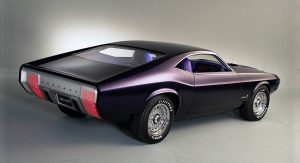
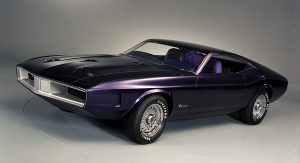 Revealed at the 1970 Chicago Auto Show, the Mustang Milano study previewed the nearly horizontal rear deck and sharp, extended nose that would be adopted by the production 1971 model. However, the rest of the car didn’t really look like any production Mustang, but the Milano profile was adopted by the Australian-market Falcon XB coupe of the mid-1970s.
Revealed at the 1970 Chicago Auto Show, the Mustang Milano study previewed the nearly horizontal rear deck and sharp, extended nose that would be adopted by the production 1971 model. However, the rest of the car didn’t really look like any production Mustang, but the Milano profile was adopted by the Australian-market Falcon XB coupe of the mid-1970s.

1980 Mustang RSX Concept
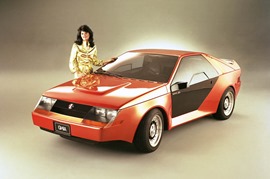 Penned by the Italian Ghia design studio, the RSX was meant to be a rally special based on the new Fox-body third-generation Mustang that debuted for the 1979 model year. It had a one-inch-wider track and 5.6-inch-shorter wheelbase than the road-going Mustang, plus extra ride height to help it deal with the off-tarmac stages of European rallies.
Penned by the Italian Ghia design studio, the RSX was meant to be a rally special based on the new Fox-body third-generation Mustang that debuted for the 1979 model year. It had a one-inch-wider track and 5.6-inch-shorter wheelbase than the road-going Mustang, plus extra ride height to help it deal with the off-tarmac stages of European rallies.

1990 “Bruce Jenner”, “Rambo” Design Studies
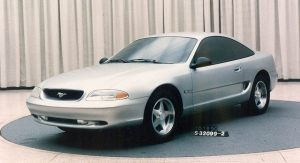
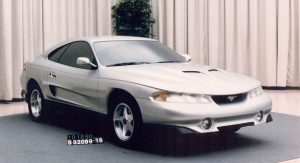 In 1990, Ford designers considered a number of themes for a replacement for the long-running third-generation Mustang, with the new generation to drop notchback and hatchback bodystyles for a fastback coupe format. This “Bruce Jenner” concept featuring elements like the galloping pony in the grille, side scoops and tri-bar taillamps, wasn’t considered aggressive enough to be a Mustang. On the other hand, the “Rambo” proposal was deemed too extreme for production.
In 1990, Ford designers considered a number of themes for a replacement for the long-running third-generation Mustang, with the new generation to drop notchback and hatchback bodystyles for a fastback coupe format. This “Bruce Jenner” concept featuring elements like the galloping pony in the grille, side scoops and tri-bar taillamps, wasn’t considered aggressive enough to be a Mustang. On the other hand, the “Rambo” proposal was deemed too extreme for production.

1992 Mach III Concept
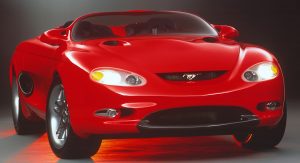 The Mach III study offered the first public hints of the new design direction for the fourth-generation Mustang. While the 1994 Mustang featured classic elements like the grille pony badge, side scoops and tri-bar taillamps, the two-seater layout and the low-cut speedster windshield have remained showcar elements.
The Mach III study offered the first public hints of the new design direction for the fourth-generation Mustang. While the 1994 Mustang featured classic elements like the grille pony badge, side scoops and tri-bar taillamps, the two-seater layout and the low-cut speedster windshield have remained showcar elements.

PHOTO GALLERY



